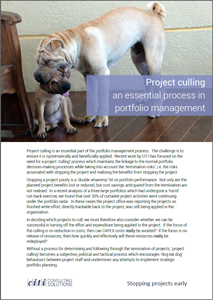 Project culling is an essential part of the portfolio management process. The challenge is to ensure it is systematically and beneficially applied. Recent work by CITI has focused on the need for a project 'culling' process which maintains the linkage to the normal portfolio decision-making processes while taking into account the 'termination risks', i.e. the risks associated with stopping the project and realising the benefits from stopping the project.
Project culling is an essential part of the portfolio management process. The challenge is to ensure it is systematically and beneficially applied. Recent work by CITI has focused on the need for a project 'culling' process which maintains the linkage to the normal portfolio decision-making processes while taking into account the 'termination risks', i.e. the risks associated with stopping the project and realising the benefits from stopping the project.
Stopping projects early poorly is a 'double whammy' hit on portfolio performance. Not only are the planned project benefits lost or reduced, but cost savings anticipated from the termination are not realised. In a recent analysis of a three large portfolios which had undergone a 'torrid' cut-back exercise, we found that over 30% of curtailed project activities were continuing under the portfolio radar. In these cases the project office was reporting the projects as finished while effort, directly trackable back to the project, was still being applied in the organisation.
In deciding which projects to cull, we must therefore also consider whether we can be successful in turning off the effort and expenditure being applied to the project. If the focus of the culling is on reduction in costs; then can CAPEX costs really be avoided? If the focus is on release of resources; then how quickly and effectively will these resources really be redeployed?
Without a process for determining and following through the termination of projects, 'project culling' becomes a subjective, political and tactical process which encourages 'dog eat dog' behaviours between project staff and undermines any attempts to implement strategic portfolio planning.









